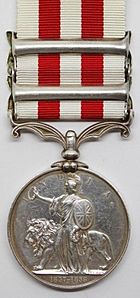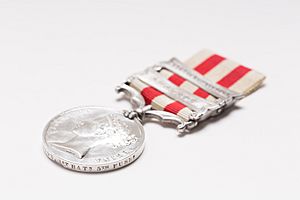Indian Mutiny Medal facts for kids
Quick facts for kids Indian Mutiny Medal |
|
|---|---|
| Type | Campaign medal |
| Eligibility | British and Indian forces. |
| Awarded for | Campaign service. |
| Campaign(s) | Indian Mutiny 1857–58. |
| Description | Silver disk, 36mm diameter. |
| Clasps |
|
| Statistics | |
| Established | 1858 |
| Ribbon: White with two red stripes. | |
The Indian Mutiny Medal was a special award given to soldiers and officers. It was created in August 1858. This medal honored British and Indian troops. They received it for their service during the Indian Mutiny. This was a major uprising that happened in India.
At first, only troops who fought directly in battles received the medal. But in 1868, the rules changed. More people became eligible for the award. This included anyone who carried weapons or faced gunfire. Even members of the Indian legal system and civil service who were caught in the fighting could get one. About 290,000 medals were given out in total. In 1862, a special dog named Private Derby even received this medal! He was the mascot of the 95th (Derbyshire) Regiment of Foot.
What Does the Indian Mutiny Medal Look Like?
The Indian Mutiny Medal is a round silver disk. It is about 36 millimeters wide. It has designs on both sides.
Front Side of the Medal
The front side of the medal shows a picture of a young Queen Victoria. She is wearing a crown. Around her head, it says "VICTORIA REGINA". This means "Queen Victoria" in Latin. A famous artist named William Wyon designed this side.
Back Side of the Medal
The back side of the medal shows a figure called Britannia. She is a symbol of Britain. Britannia is wearing a helmet. She holds a wreath in her right hand. She also has a shield with the British flag on her left arm. A lion stands in front of her. Above Britannia, it says "INDIA". Below her, you can see the dates "1857–1858". These dates show when the Indian Mutiny happened. Leonard Charles Wyon designed and carved this side of the medal.
The Medal's Ribbon
The medal hangs from a special ribbon. This ribbon is about 1.25 inches wide. It is white with two bright red stripes. All the stripes are the same width. The name of the person who received the medal is carved on its edge. Their military unit is also written there.
Special Clasps for the Indian Mutiny Medal
Sometimes, a medal came with extra metal bars called clasps. These clasps were attached to the ribbon. They showed that the person had served in important battles or areas. Five different clasps were created for this medal. However, no one received more than four clasps on their medal. The clasps were read from top to bottom.
Delhi Clasp
This clasp was for service between May 30 and September 14, 1857. It was given to troops who helped recapture the city of Delhi.
Defence of Lucknow Clasp
This clasp covered the period from June 29 to November 22, 1857. It was given to the original defenders of Lucknow. This included students and teachers from La Martinière College. They helped defend the Residency building. The first group that came to help them, led by Sir Henry Havelock, also received this clasp.
Relief of Lucknow Clasp
This clasp was for service in November 1857. It was awarded to the second group of soldiers who came to help Lucknow. This force was led by Sir Colin Campbell.
Lucknow Clasp
This clasp covered service from November 1857 to March 1858. It was given to troops under Sir Colin Campbell. They were involved in the final battles to take control of Lucknow. They also helped clear the areas around the city.
Central India Clasp
This clasp was for service between January and June 1858. It was given for actions during the Central Indian campaign. This included soldiers who fought under Major-General Sir Hugh Rose. They fought in places like Jhansi, Kalpi, and Gwalior. It also went to those who served with Major-General Roberts in the Rajputana Field Force. And to Major-General Whitlock from the Madras Army.
Many medals were given without any clasps. This usually happened to those who served during the Mutiny but were not part of these major battles. Most of these awards were made after the rules were changed in 1868.




